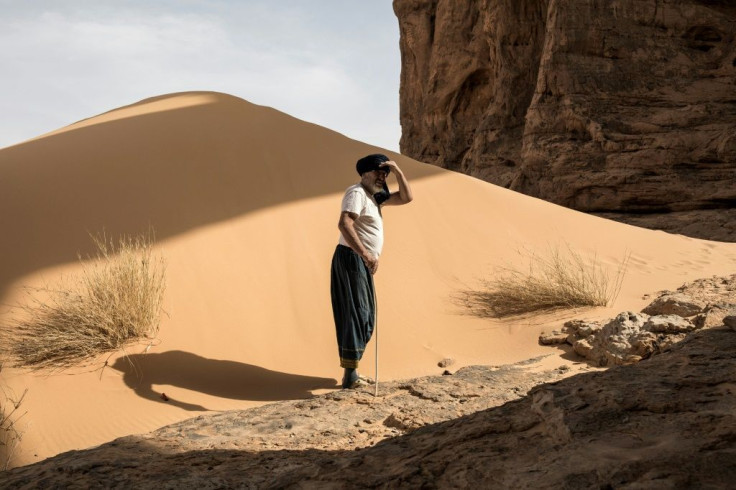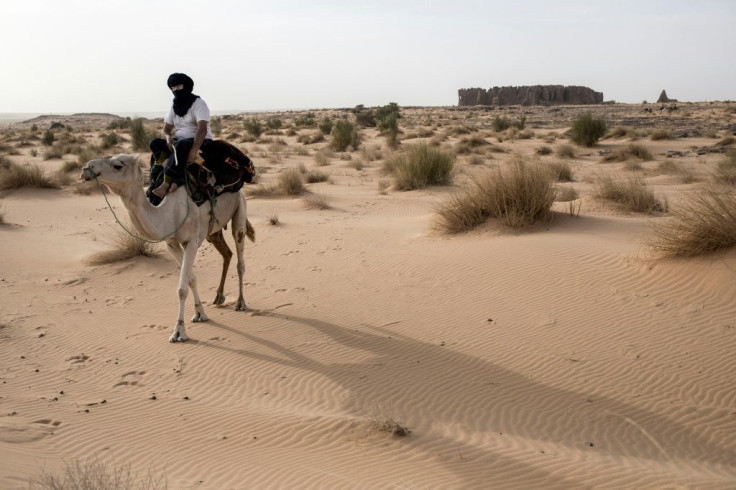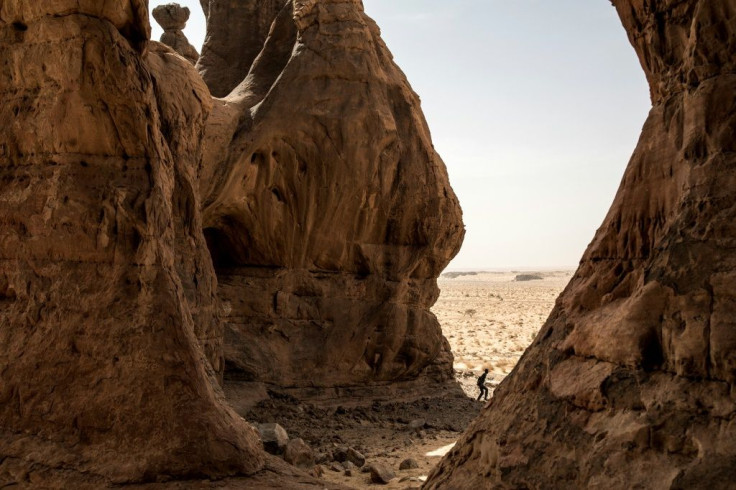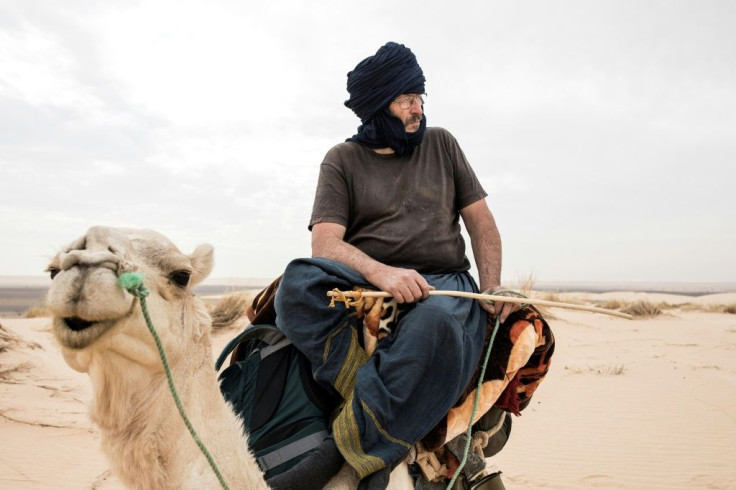On A Caravan, With One Of The Sahara's Last European Explorers
Climbing into the saddle, he adjusts the scarf protecting his head from the sun and, with a tap on the camel's back, the caravan sets off.
Thierry Tillet is again off to explore the vast Saharan desert, at the head of a nine-camel convoy with three other riders.
At 68, the Frenchman is one of the last European explorers since the end of the 19th century to dedicate much of his life -- 47 years -- to crisscrossing the Sahara.
This expedition, which began before the coronavirus epidemic, starts and ends at two desert jewels in central Mauritania.
From Tichitt, the convoy is headed east to Oualata, 300 kilometres (185 miles) away, travelling in single file over a sandy, rocky landscape.
For the first time, Tillet -- or Ghabidine, as a Tuareg friend renamed him -- is taking journalists along "so that this knowledge reaches the general public".
Perched on the back of his swaying camel, Tillet wears an old, holey T-shirt and worn sandals.
With his tousled, white hair and stubbled chin, it's easy to forget he's an authority in his field.
For many years he was a member of the anthropology laboratory at France's National Centre for Scientific Research (CNRS).
He was also professor of prehistoric archaeology at Grenoble University and taught in Chad, Niger and Mali.

Throughout, he would go back and forth to the Sahara.
He has documented Neolithic civilisations, overseen the inventory of Malian archaeological sites and discovered a dinosaur skeleton in the Tenere desert in Niger.
"Sometimes, small fragments of discovered tools contain more information than a dinosaur, even if it's less spectacular," Tillet says.
Exploring the history of the world's largest expanse of arid land is a hugely diverse venture.
It can range from the forgotten religious centres of Sufi brotherhoods in northern Mali, to the sandstone plateaus in northeastern Chad and prehistoric Saharan settlements in Niger.
But trading his camel for the comfort of an air-conditioned vehicle as his mode of transport isn't an option for Tillet.
"You're going at the speed of the camel, and that allows me to observe and spot a number of things on the ground," he says.
"In a car I wouldn't be able to do that, it moves too quickly."
Each trip brings something new, be it publications in scientific works, "a few stones brought back for research" or photos of objects from the Neolithic era, the last period of the Stone Age.

Currently it's an 11th-century caravan depot lost in the Mauritanian dunes, the Ma'den Ijafen, that begs to be found.
"It was Theodore (Monod, the late French explorer) who discovered it in 1956," Tillet says.
"He asked me to go back there."
For three years now, he has been searching and, on this expedition, wants to ask around among nomadic shepherds.
Tillet does not consider himself an adventurer or a daredevil.
"Exploration carries with it a fantasy. I'm not trying to discover the unknown, but to discover what exists!" he says.
"That is true scientific exploration."
In this part of the Sahara, prehistoric artefacts are everywhere, constantly revealed by an omnipresent wind, but indistinguishable to the untrained eye.
"In a continental climate, it's often necessary to dig... Here, it's all on the surface."

Without warning, he pulls the reins to stop, on spotting something interesting.
If he doesn't know what it is, he takes notes and -- in his only recourse to 21st-century technology -- satellite coordinates using a GPS.
Once home in southwestern France's Perigord region, he will transfer them onto a map, tirelessly completing what he calls his "spider's web".
The hundreds of GPS points are not only a scientific record but suggest the route of his next expedition.
Tillet, the son of Parisian bakers, said his love of Africa and archaeology began after hearing stories as a child.
But it was his first university professor who ignited the desire to go and see it for himself, encouraging him to focus on the Sahara.
On his first trip -- in Algeria -- it rained a lot.
"For someone wanting to study the Sahara, it was a bad start!" he says, laughing.
Tillet's wife occasionally used to accompany him on his explorations.

But this time, his companions are Ahmadou, Sheih and Ahmed, whom he has known for many years.
Looks, gestures and common phrases in mixed mother tongues make up for any language barriers.
The days are punctuated by the same rituals: a sunrise departure, stops to drink green tea and finding a place where they can make supper before sleeping under the stars as the camels graze.
After two days, the caravan stops at Akreijit, an archaeological site discovered in 1934 by Monod and partly restored by a French team at the end of the last century.
The foundations of the old buildings are visible again.
European tourists disembark from their 4x4s in a cloud of dust and briskly visit the old town, just last year removed from the "red zones" where the French foreign ministry advises against travel.
Tillet looks for a drawing of a bull on a rock, located during a previous visit.
"It is two metres (6.5 feet) long," he says. "My GPS point tells me it's in 22 metres."
He scans and searches, passing repeatedly through the ruins, but finds nothing.
Concerned about kidnappings, the French authorities are not always happy about the caravan's off-the-radar trips.
"These people are as worrying as they are fascinating, so we have to keep an eye out," a French diplomat in the sub-region later told AFP.
Three-quarters of the caravan's route are in areas that travellers are officially advised by the French government to avoid.
"Objectively, he sometimes puts himself at great risk," acknowledged Pierre Touya, president of the Association of Saharans which groups archaeologists, geographers and other enthusiasts.
Still, "he remains rational, does very good research and is supported by local knowledge," he said.
On-the-ground information from locals is key to Tillet's preparations before leaving.
By email and phone, he finds out about nomadic tribes' movements or where there are wells for the animals to drink.
For decades, the region has been buffeted by inter-communal clashes, separatist insurgencies and conflicts between religious groups -- and Tillet has often found himself on the front row.
In the 1990s, he met Iyad Ag Ghaly, then a rebel leader and now head of one of the main jihadist coalitions.
He also met French ethnologist Francoise Claustre in Chad before she was kidnapped in 1974 by Hissene Habre's rebels.
And he has shared mechoui, a meal of slow-roasted lamb, with former Malian president and fellow archaeologist Alpha Oumar Konare.
"As long as I don't bump into the bastards, it's all right," he smiles, talking about the jihadists, who are an escalating threat in the Sahel region.
In 2009, he was forced to hide in the northern Malian town of Kidal.
Alerted to the presence of "likely unfriendly" groups at a time when Tuareg independence rebellions and jihadist groups were emerging, he left at 4:00 am in a pick-up truck, his head down and face hidden.
That same year, he and his camel team were woken in the night by the blinding light of a surveillance drone in the desert of Mali's Taoudenit region.
The jihadist expansion in the Sahel-Saharan strip has reduced exploration possibilities.
But, according to a source close to the authorities, interviewed in Mauritania's capital, Nouakchott, a security grid set up a decade ago to counter the emerging jihadist influence is "once again allowing scientists and tourists to come".
It's day four and, after a cold night, he groans from the pain of an old foot injury as he climbs into the saddle.
But, neither the discomfort nor deteriorating regional security will stop him.
This desert is "the place where I feel the best, where you can't go wrong", he says.
When he reaches Oualata near the Mali border after what will have been a two-week journey, Tillet plans to relax and drink tea with an old acquaintance.
Even if he didn't find the elusive caravan depot this time, he's happy with the information gleaned.
Previously the projects were funded by his former employer, the CNRS, but since retiring in 2012, he pays the several thousand euros needed for the trip himself.
Monod got off his camel for the last time aged 93 and Tillet, a member of the French Society of Explorers, hopes to go on for a long while yet.
"There's still so much to document," he says.
For next year he is planning his longest route so far, at more than 1,000 km, back in the Sahara, with its many silences but, as he says, "where it's never boring".
ah/lal/erc/kjm
© Copyright AFP 2024. All rights reserved.





















